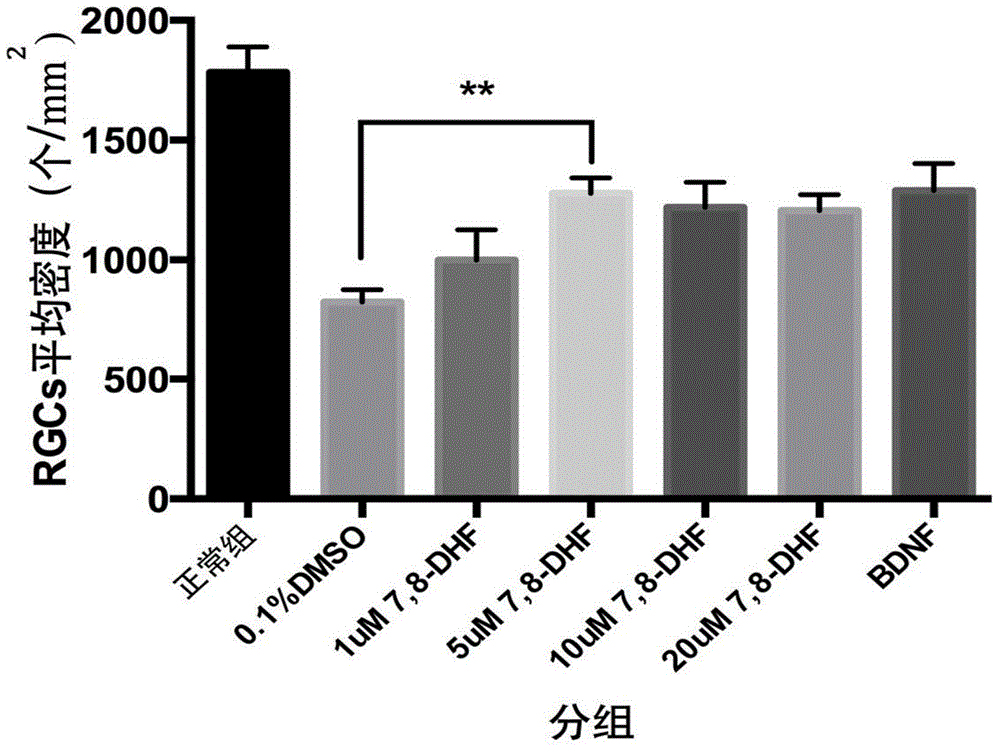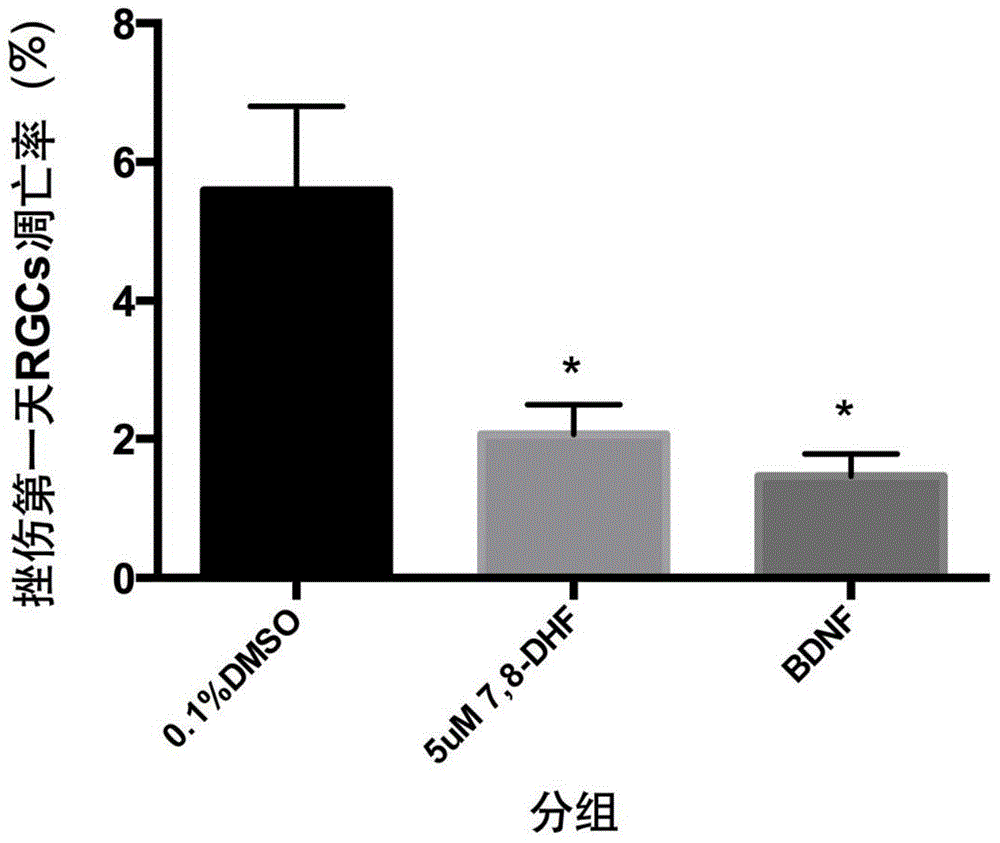Application of 7,8-dihydroxyflavone (DHF) to preparation of drug for treating retinal degenerative diseases
A technology of dihydroxyflavone and retinal degeneration, applied in 7 fields, can solve the problems that have not yet been seen
- Summary
- Abstract
- Description
- Claims
- Application Information
AI Technical Summary
Problems solved by technology
Method used
Image
Examples
Embodiment 1
[0022] Example 1: DiI reverse labeling cell counting method to detect the protective effect of 7,8-dihydroxyflavone on damaged retinal ganglion cells (RGCs)
[0023] ①Experimental objects and groups
[0024] Experimental object: adult male SD rats (about 200g);
[0025] Randomly divided into experimental group, negative control group, and positive control group (n=5); the experimental group was further divided into 4 subgroups, and 7,8-DHF 4uL of four concentrations of 1uM, 5uM, 10uM and 20uM were injected into the vitreous cavity respectively , the negative control group was injected with 0.1% DMSO solution 4uL into the vitreous, and the positive control group was injected with 0.5ug / uL BDNF 4uL into the vitreous;
[0026] Brain-Derived Neurotrophic Factor (BDNF) has a significant protective effect on retinal neurons. It has been confirmed in various animal models such as optic nerve contusion and transverse injury that BDNF can protect retinal ganglion cells (RGCs) and prom...
Embodiment 2
[0033] Example 2 Apoptosis in situ cell apoptosis detection method (TUNEL detection) to observe the anti-apoptosis test of 7,8-dihydroxyflavone on damaged retinal ganglion cells (RGCs)
[0034] ①Experimental objects and groups
[0035] Experimental object: adult male SD rats (about 200g);
[0036] They were randomly divided into experimental group, negative control group and positive control group (n=3). The experimental group was injected with 5uM concentration of 7,8-DHF 4uL into the vitreous, the negative control group was injected with 0.1% DMSO solution 4uL, and the positive control group was injected with 0.5ug / uL BDNF 4uL;
[0037] ②Establishment and administration of optic nerve contusion animal model: After general anesthesia by intraperitoneal injection of ketamine (80mg / kg) and xylazine (12mg / kg), SD rats were cleaned and disinfected around the left eye, and circularly cut open the bulbar conjunctiva of the outer canthus , Open Tenon's capsule, bluntly dissect the...
Embodiment 3
[0042] Example 3 GFAP immunohistochemical detection to observe the effect of 7,8-dihydroxyflavone on maintaining the microenvironment of damaged retinal ganglion cells (RGCs)
[0043] Glial fibrillary acidic protein (GFAP) is a cytoplasmic filamentous protein that exists in different glial cells of the central nervous system and is an indicator reflecting the extracellular microenvironment. Studies have shown that the expression of GFAP increases High is a non-specific marker of damage to the central nervous system, and the activation of glial cells is one of the important reasons for the loss of RGCs in glaucoma and other optic nerve diseases. Immunohistochemical detection and semi-quantitative analysis were performed on the expression level of GFAP in the retinal sections of each group, and the protective effect of 7,8-DHF on retinal ganglion cells was indirectly reflected by comparing the differences in the expression level of GFAP among the groups;
[0044] ①Experimental o...
PUM
 Login to View More
Login to View More Abstract
Description
Claims
Application Information
 Login to View More
Login to View More - R&D
- Intellectual Property
- Life Sciences
- Materials
- Tech Scout
- Unparalleled Data Quality
- Higher Quality Content
- 60% Fewer Hallucinations
Browse by: Latest US Patents, China's latest patents, Technical Efficacy Thesaurus, Application Domain, Technology Topic, Popular Technical Reports.
© 2025 PatSnap. All rights reserved.Legal|Privacy policy|Modern Slavery Act Transparency Statement|Sitemap|About US| Contact US: help@patsnap.com



